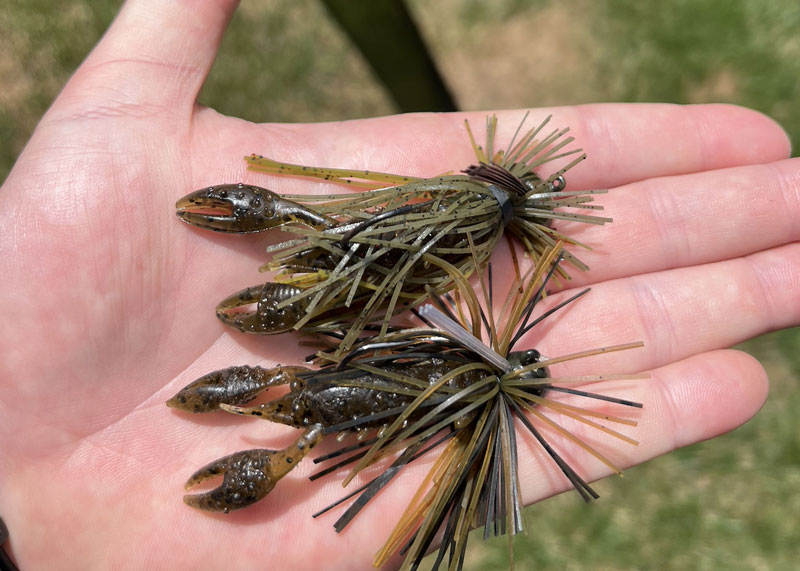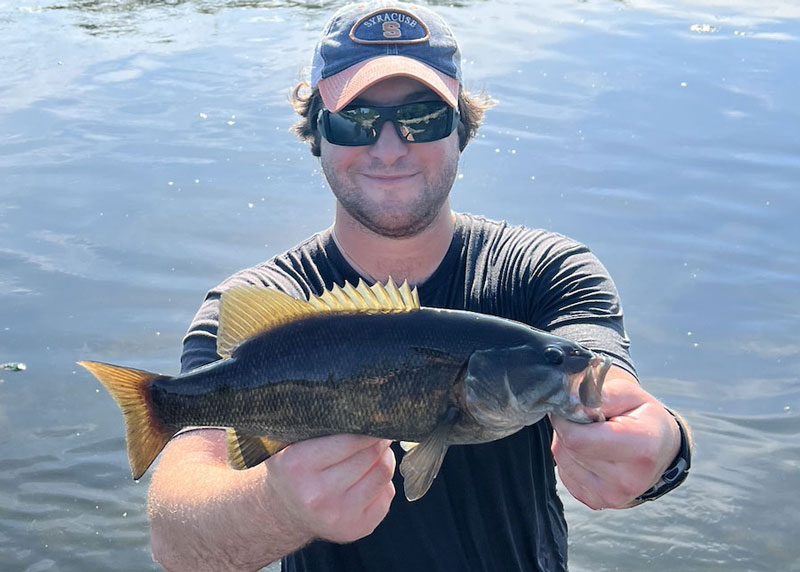You’ve made it to the river – finally, away from all your stress and responsibilities – in pursuit of some mean ‘ol smallmouth bass. You find a juicy looking bunch of isolated boulders to cast at. The only thing left to do is open that tackle box and tie on a lure… but what are they eating? Crawfish, crawfish, crawfish. These little mudbugs are found pretty much everywhere in the lower 48, and they are a smalljaw’s favorite food. When considering “matching the hatch,” I almost always start with craw imitations.

How to Dance the Crawfish Jig
Now, I know a lot of beginner anglers struggle with fishing jigs for bass. I couldn’t get a bite on a jig to save my life until one glorious afternoon some years ago on the Oneida River in central New York. The water was as clear as I’d ever seen it. Schools of gizzard shad and yellow perch darted about. After working a jerkbait and flipping a Texas-rigged worm for over an hour, I had yet to hook into a bass.
I looked down and saw a big old crawfish by my feet. He was on the move, kicking his tail and rising just off of the bottom before falling back down to the mud again. Like this: kick, kick, fall. Kick, kick, fall.
As a last ditch effort, I tied on the only jig in my tackle box at the time, chucked it a few feet in front of me, and imitated the craw’s motion. I watched how the lure responded to the twitches of my rod and adjusted my movements accordingly until I got that kick, kick, fall just right. Then, I threw a half-hearted cast along a downed tree and began to retrieve my lure as I had just practiced.
Bam. Much to my surprise, the jig got hammered and I pulled up a healthy smallmouth bass. Picture, release, cast again, this time with more gusto. Wham, another football. I caught around half a dozen fish before the sun went down and it was time to pack it in. But man was I excited to bring this technique home to my local river, the Potomac. I have, and it catches tons of bass. Try it for yourself, and you won’t be disappointed.

Smallmouth Jig Options
A finesse jig paired with a soft plastic, craw style trailer is one of the most effective lures for smallmouth bass in our region’s rivers. You’ll want to pick a one-eighth ounce to a quarter-ounce size for slower current and a half ounce jig for situations with faster moving water. Smallmouth will often hit a finesse jig on the fall, so it’s important for the lure to sink slowly and give the skirt and trailer plenty of time to perform their tantalizing dance in the water column. But if you use a jig that is too lightweight for the speed of the river’s current, it gets swept out of the strike zone before reaching the bottom. And if you pick one that’s too heavy, you’ll be getting snagged in between cracks of the rocky riverbed every other cast. Finding that happy medium, that sweet spot, is how you will get more bites.
In terms of soft plastic trailers, I like a 2.5- to 3.5-inch craw imitator made from a buoyant material – anything that allows the claws to float when your jig rests on the bottom. Baits with two little claws or kickers are key for an effective finesse jig trailer, creating vibration and further slowing down the lure’s fall rate. Color selection is the same for both the jig and trailer; it will depend on water clarity. For clear water use natural colors such as green pumpkin or PB&J. In stained water, use dark colors such as black/blue or black/brown. I will typically match my trailer color to my jig color.
One more word of advice before you tie on that jig: use a fluorocarbon leader. Especially on days when the water is gin clear, smallmouth can become very line shy. A monofilament leader can work too, but fluorocarbon is more resistant to abrasion from all the hard structure you’ll be fishing around and is also less visible to fish than mono. Three feet to four feet of eight-pound to 12-pound test will suffice.
Rhythm to the Beat
There are several nuances you’ll want to take into account after mastering that kick, kick, fall motion of the jig. First and foremost is your pause, or how long you let your jig sit on the bottom before working it again. A crawfish in defensive position triggers the predatory instinct in a smallmouth bass to attack. So, if you don’t get a reaction bite from the fall or moving action of the jig, allow your lure time to pause and imitate a defensive craw. When your jig is resting on the bottom, the buoyant, soft plastic claws will rise and sway in the current, just as a crawfish raises up his claws when threatened.
So, how long do we pause? The answer is different every day. My general rule of thumb is the colder the water, the longer the pause. A bass’s metabolism slows way down in the colder months, making him less inclined to chase a faster moving bait. During the warmer times of year, the bass’s metabolism is up. He is hungry and will be much more willing to chase after prey on the move.
The best way to key in on how long the fish want a pause is to pick a baseline number of seconds and work your way up from there. For example, on a mild day in late October, three seconds is a solid baseline. Make a few casts; kick, kick, fall, count to three; kick kick fall, count to three, etc. No bites yet? Keep casting, but increase your pause count to five seconds. Still nothing? Try eight seconds. And so on. Adjust your baseline for warmer and colder water temperatures accordingly. Remember, every jig needs some rhythm to go along with the beat — now get out there and hit the dance floor.
-By Adam Greenberg, FishTalk Magazine's totally awesome former intern.